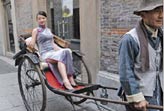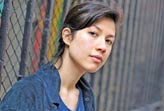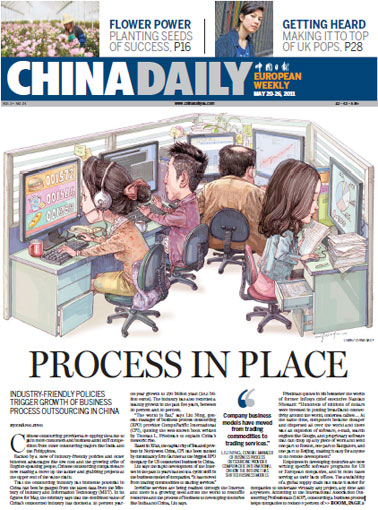Books
A family act
Updated: 2011-05-19 07:58
By Yang Guang (China Daily)
|
 Lin Zhu (right), the second wife of Liang Sicheng, and Liang's daughter, Liang Zaibing (left), unveil the bilingual edition of Liang's monograph Chinese Architecture: Art and Artifacts during a commemoration ceremony honoring Liang at Tsinghua University in April. Zhou Wong / for China Daily |

The Liangs have been gifted visionaries persecuted for their dreams for generations. The country is now celebrating the 110th birth anniversary of renegade architect Liang Sicheng. Yang Guang reports.
When the country's most famous environmental activist Liang Congjie (1932-2010) said he came from a "family of losers", he was talking about all three generations. While the Liangs have been celebrated for their extraordinary powers of vision and aptitudes, none of their societal aspirations were realized in their lifetimes, which they spent facing persecution.
Congjie's grandfather was philosopher and reformer Liang Qichao (1873-1929), who was exiled to Japan for 14 years after the short-lived Hundred Days' Reform in 1898. The campaign aimed to reinvent China as a constitutional monarchy and set it on the path to modernization.
Qichao's son, Liang Sicheng (1901-72), was persecuted and denounced during the "cultural revolution" (1966-76) for his unsuccessful campaign to preserve Beijing's ancient city walls.
Congjie founded the country's first legally recognized environmental protection organization, Friends of Nature, in 1994. But his green dreams are yet to be realized, too.
Congjie, who was persecuted during the "cultural revolution", believed "social commitment" was the thread that bound the generations of his family.
Qichao emphasized the term in a speech he delivered at Tsinghua University in 1914 and it was later incorporated into the university's motto.
This year marks the 110th anniversary of Sicheng's birth. Grand activities have been staged in his honor at Tsinghua University, the architecture department of which Sicheng founded in 1946.
And Foreign Language Teaching and Research Press has published Chinese Architecture: Art and Artifacts, a bilingual collection of Sicheng's treatises on Chinese architectural history and studies.
The State Administration of Cultural Heritage last year certified the former residence he shared with his wife, architect and writer Lin Huiyin (1904-55), in Beijing's Beizongbu Hutong as "immovable cultural heritage".
Sicheng, who is hailed as the "father of modern Chinese architecture", wrote the country's first modern architectural history book. He was also the Chinese representative on the design board of the United Nations headquarters in New York.
Sicheng and Lin were both commissioned in the early 1950s to design New China's national flag and emblem, and the Monument to the People's Heroes in the center of Tian'anmen Square.
Princeton University's statement from when it awarded Sicheng an honorary doctorate in 1947 calls him "a creative architect who has also been a teacher of architectural history, a pioneer in historical research and exploration in Chinese architecture and planning, and a leader in the restoration and preservation of the priceless monuments of his country".
Sicheng was born during his father's exile in Japan. At age 14, he enrolled in Tsinghua College, a preparatory school for students to be sent by the government to study in the United States.
Sicheng and Lin went to the University of Pennsylvania to study architecture in 1924. He received a master's degree three years later.
The couple wed in 1928 and returned to China the same year to teach at the Northeastern University in Liaoning's provincial capital Shenyang.
Sicheng started his career with a strong drive to study traditional Chinese architecture and building methods.
He and Lin spent the 1930s traveling through the countries' then 15 provinces to study and document more than 2,700 architectural relics.
In 1934, Sicheng published his first book, Qing Structural Regulations. His monumental History of Chinese Architecture was completed in 1944. His manuscript, A Pictorial History of Chinese Architecture, was posthumously published in 1984. It was edited by American historian of Chinese art and architecture Wilma Fairbank, the wife of John King Fairbank.
In 1950, Sicheng put forward a comprehensive and systematic urban planning proposal with architect Chen Zhanxiang (1916-2001). The plan called for the establishment of a new administrative center in the western suburbs while preserving the old city walls and towers.
The proposal was not adopted. Sicheng argued with the authorities in vain. He sobbed as he watched the walls and towers being demolished.
"Removing a tower is like digging out a piece of my flesh. Removing a brick is like peeling a layer of my skin," he said.
Liang was condemned during the "cultural revolution" as an "authority of counter-revolutionary scholarship". On his deathbed, he told Chen, who came to visit, not to lose confidence in their motherland.
"Whatever hardships we must endure in life, make sure to be loyal to the country and have faith in our academic research," he said.
In 1994, Fairbank published the couple's biography Liang and Lin: Partners in Exploring China's Architectural Past. The Fairbanks had known Sicheng and Lin since the 1930s and maintained correspondence with them for over a decade.
Jonathan Spence, a leading scholar of modern Chinese history and former Yale University professor, writes in the book's foreword:
"Myriad layers of society's waste cluttered up and ravaged their lives, and at so many times the world simply gave them no room to breathe. But, as we ponder their story further we become more conscious of the flashes of light that emanate from this strongly yet stressfully married couple," he continued.
"We see vanished buildings regain their rightful place in a nation's consciousness. We sense the humor and fortitude that never left them, even during prolonged and debilitating illness."
E-paper

Thawing out
After a deep freeze in sales during the recession, China’s air conditioner makers are bouncing back
Cool Iron lady
Of good and evil
Build on security initiatives
Specials

Memory lanes
Shanghai’s historic ALLEYS not just unique architecture but a way of life

Great expectations
Hong Kong-born singer songwriter rises to the top of the UK pops.

A diplomat of character
Belgian envoy draws on personal fascination to help build China ties.
